Many of you want to know if you need to consider your wood floor colour when choosing a paint colour for your walls. So, here’s my colour expert advice for what to do when your wood floor colour is no longer neutral and when you can ignore your wood floor colour.
Recently, I’ve been talking a lot about formal warm wood tones on the blog. Because many of you want to know how to work with them, and when it would be best just to tear them out and start over.
Also, I’ve seen SO MANY people make the mistake of trying to match the undertone of their paint colour to their wood floors. It’s a question that lands in my inbox often. And I want to SAVE YOU from making this mistake too.

One of my students, who is actively learning and practicing her eye for colour shared this:
Hi All!
This is just part of my daily colour exercising. When a floor like the one in the attached photo is so bossy, is the only choice to do an orange undertone neutral on the walls? I know that we don’t usually base colour choices on the wood floor, but this one is screaming. Also assume that the client wants to change out all other cabinet, counter top, tile & soft furnishing colours.

And her instincts are right that these floors do need to be handled slightly differently than wood floors that are a bit more neutral (in other words, more BROWN). But pulling in more orange with the paint colour is not the answer.
A more saturated and red-orange floor like this certainly IS bossier, less timeless and less versatile than a more muted cognac (orange-brown) floor. That means it will limit your decorating, but the wall colour needs to contrast and balance it, not match it.
When NOT to match your wall colour to your floor colour
So NO, the walls should not have an orange undertone to relate to the floors. That would not create a beautiful result.
But a very pale orange beige complex cream? YES! Because it’s going to look more like cream on the walls. But choosing a deeper orange beige would only be too much orange.
Better to repeat it in your decorating and keep the walls anything but orange or red truly.
DON’T try to match the undertone of the paint colour to your wood floors
It’s a very common impulse for novice decorators to want to match the paint colour to the floors.
But it’s a mistake.
Often it’s because there is simply nothing else worth looking at in the room, so they want to relate the wall colour to the wood.
And by the way, in general, my neutral colour wheel is not intended to identify undertones in wood. Wood floors that really need to be addressed in your decorating, for example. those that are straight-up orange or red (NOT orange-brown or red-brown) are going to be more saturated and less neutral than any of the colours on the wheel.
And more neutral hardwood floors can be treated like a pair of blue jeans, they go with everything. More saturated ones that are more orange or red than brown ARE more limiting. They are a COLOUR that needs repeating, but matching the wall colour to them is not the answer.
Taking your wood floor colour into consideration is still NOT about coordinating undertones
In my System, I teach that when you’re working with neutrals, that’s when you are identifying and coordinating the subtleties of undertones.
But when you are working with saturated colours (colours that are clearly recognizable as one hue like red or orange), it’s no longer a conversation about undertones. Now we are coordinating accent colours working with harmonizing clean and dirty colours and creating balance and flow.
So I would recommend quite the opposite of choosing a warm orange undertone neutral for the walls. If these floors (in her photo above) stay, everything else needs to be cooled way down to create balance.
Here’s what I mean. The cabinets should be white. Adding deep blues also work well to balance orange and red wood tones. Remember this cherry cabinet kitchen? And the reddish-orange of the floors should be treated as an accent colour.
Something like this below would work well for the kitchen.
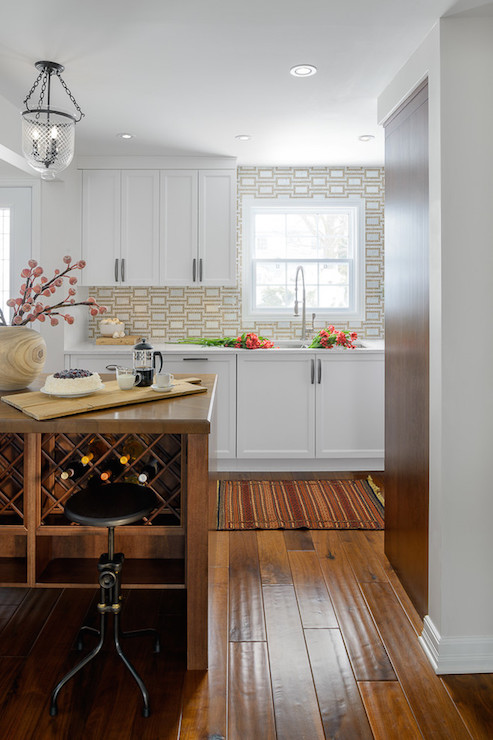
The walls will look best in a complex cream or pale greige. And I would make liberal use of light area rugs to further break up the bossy red-orange floors.
By the way, it’s also worth mentioning that you are very likely to get warm orange/pink reflections on your pale wall colours with floors like these. There’s no way around this. However, the more you add light or neutral furnishings and rugs, the less intense it’s going to be.
Let me just repeat: when you have red-orange floors like these, or even more saturated ones (more on that below), you are now decorating around an existing accent colour.
Here are 3 of the best ways to decorate with red or orange
And if this is the situation in your house, treat your floors like an accent colour and think about contrast, balance and repetition:
1. Add ample white or cool light colours for balance. Walls, drapes, area rugs, more area rugs, lamps and upholstery.
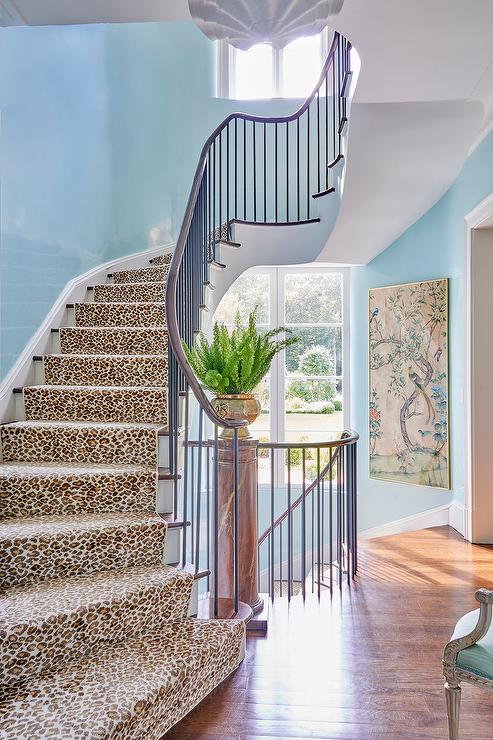
Leopard is sooo good for picking up warm colours like yellow, red and orange | decorpad
2. Repeat the colour of the floors in your wood stained furniture
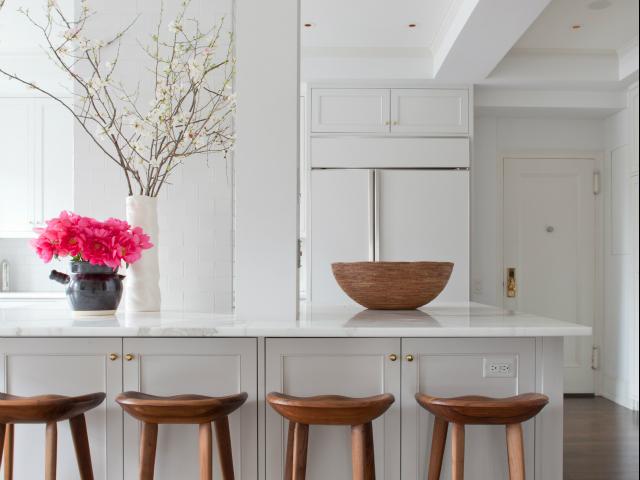
Repeat the colour of your wood floors in your counter stools | decorpad
3. Add another rich accent colour to contrast if you like, deep blue is a great choice.
The more saturated your wood stain is, the less versatile your colour palette
You might be wondering, at exactly what point does a warm red or orange floor become TOO red or orange?
It’s tricky because the line where a pretty rich brown tips into a red, orange or burgundy is necessarily somewhat subjective. But I want to give you an idea of where that line falls for me.
You can always see red and orange in warm brown when you’re looking for it. But it’s how relatively saturated those hues are that matters.
And by the way, while we are in this extremely cool and fresh white, black and grey trend, wood floors are often paler and even a bit grey. That means plenty of perfectly pretty neutral wood floors are looking too “warm”, “orange” or “red” to our eyes that are adjusted to the trend.
Honestly, this worries me more in terms of wasteful renovations. Because there is nothing wrong with warm brown wood floors, I think they are timeless.
So I’m going to share with you where I usually draw the line. And as I’ve written about, my tolerance of very warm wood tones is high because wood is naturally a warm material. Plus, I firmly believe in many cases, you’re better off focussing on decorating than ripping out perfectly good wood floors.
What is a relatively neutral brown wood tone?
Warmer, vintage, traditional and formal wood floors are often quite rich (especially relative to the current trend as I said). But when they are appropriate to the style of the home, they are absolutely worth working with. Think of the heavy and rich reddish-brown trim in historical Craftsman-style homes or the honey cognac oak in mid-century modern homes.
This room below, for example, features the classic rich wood tone you will find in a historic Craftsman home. It’s more neutral (less saturated and more BROWN) than my reader’s example, for sure, and it would coordinate well with a timeless warm walnut. BUT it feels completely appropriate and timeless in this house.
To decorate successfully with richer wood tones, try to create balance with lots of white or cream. You certainly have more options for pretty accent colours because the wood is more neutral and versatile.
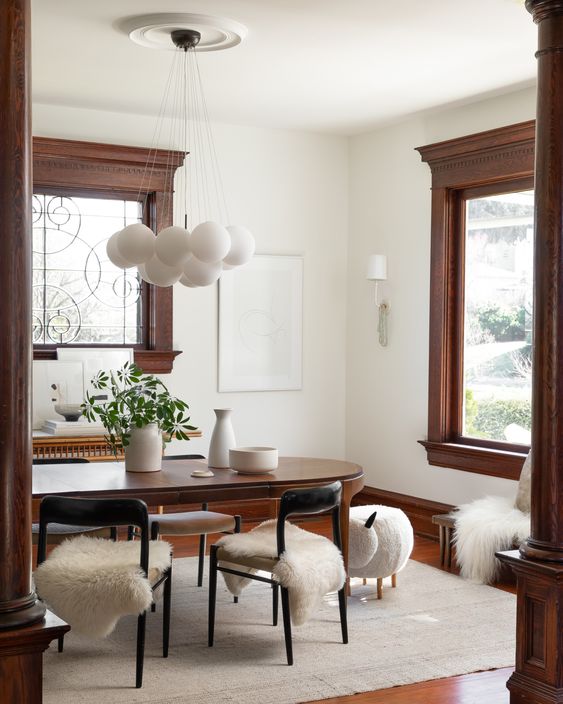
Which wood tones are too saturated to be timeless?
The exaggerated orange and red wood tones are more common in builds and renovations from around the early 90s, and they often simply look dated. They are just too exaggerated to be versatile and timeless.
Honestly, I think the example my reader shares falls into this category. So, my first choice would be to replace the floors or even paint them (more on that below), but she could also follow the decorating and painting tips above to make them work if she prefers.
So again where does a wood floor tip into the realm of too saturated to be versatile?
While it’s not simple, nor is it a hard line, my rule of thumb is:
If it’s more red than walnut or more orange than cognac. That’s the point where it’s no longer versatile and neutral.
Here’s a little stain colour chart below that is by no means exhaustive of warm wood colour options, but illustrates what I’m getting at.
See how the hot, saturated colours pop forward the way clean colours pop ahead of dirty ones? Those are the range of wood floor colours I would steer clear of or consider replacing or painting.
I’m not at all worried about even the warmest of the others though.

So I personally draw the line at exaggerated red and orange tones and especially exotic reds like Brazilian Cherry. I DO NOT want to get into the territory of specific wood species and stains here, but the more saturated the orange or red tone is, the more it’s a COLOUR that needs to be dealt with in your decorating.
How do I decorate with red floors that are basically burgundy?
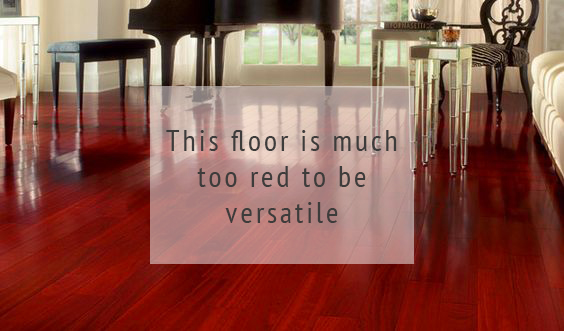
I don’t love red. It’s heavy to my eye and I think it needs lots of white to balance it out. I’m much more friendly with orange and cognac. So the one floor I would never want to live with is the Brazilian cherry-type burgundy red like the one above. Because I don’t want to be stuck decorating with red.
I can get behind always having to have a bit of orange or cognac in my decor, but burgundy red? It’s a hard pass for me.
If you love red and burgundy and you don’t mind at all having to decorate with it, maybe your exotic red floors can work for you. Just keep in mind that they are very formal (note the baby grand piano in the image above).
Update red floors with black and white
When searching for images of Brazilian cherry wood floors, I found the most current and prettiest rooms with these floors had lots of white and black like this one below.
The red floor acts as the accent colour in the room. They are getting away with the more muted walnut table and sideboard by distracting the eye with good decorating and high contrast.
Notice though, that it’s not a rustic modern or farmhouse look in any way. Rather, it’s still glam and sleek. If rustic and casual is the look you want, hot, glossy floors will work against you.
When to paint your wood floors?
I think generally people are much too afraid of painting dated wood floors. They would rather live with them because, well, they’re wood!
Let me just liberate you from the sanctity of wood. In the UK and Europe, there are so many worn-out wood floors, it’s completely commonplace to simply paint wood floors for a fresher look.
It’s funny how that’s not even an option in most people’s minds on this side of the ocean.
And it’s a shame because painted floors can be a fresh and beautiful look like this below.
Or this.
It’s probably because we tend to think of homes as investments first. What about resale?
Well, I would argue that too red or orange a wood floor is not a selling feature either. So I would choose to love the look while I live in it and paint them. The next owner will probably replace those floors anyway.
So to recap, yes, the floors in the example my reader shared tip into the realm of orange-red, a saturated colour, not a neutral. And they are not as timeless and versatile as wood floors that are browner. But if she is ok with the limitations they impose (ie. if she can live with orange-red) balancing them with lots of pale fresh neutral colour and maybe some blue or green and decorating well is still the key to creating a beautiful space.
Don’t make an expensive floor colour mistake. Get links to product colours I recommend here: Timeless Wood Flooring Guide
My last course year is Thursday and Friday, we’ll post new dates soon!
If you need help making decisions about your wood floors, you’ll need my Timeless Kitchen package, or Renovation/New Build package. Please note, our eDesign packages cannot be customized and we don’t provide individual hard finish advice. See them all here.
Related posts:
White Floors for Instant Happiness
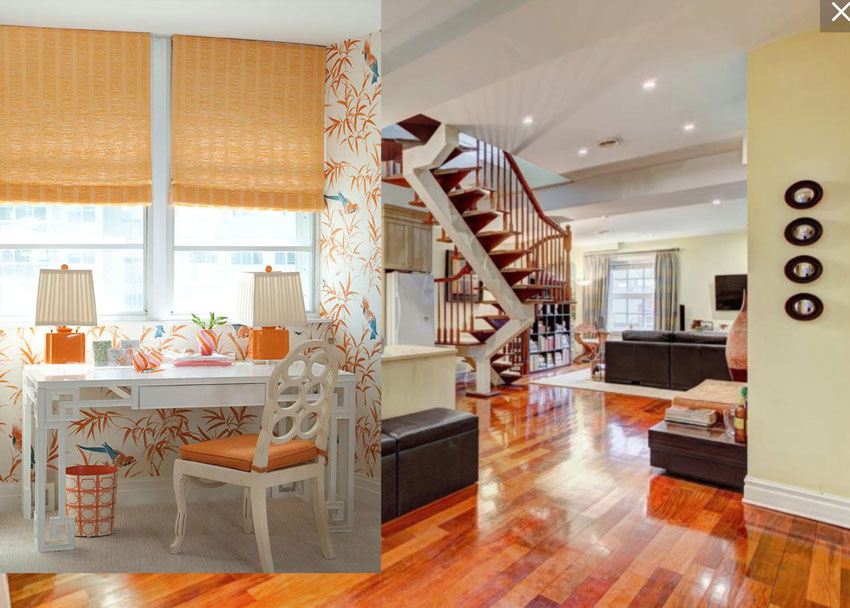
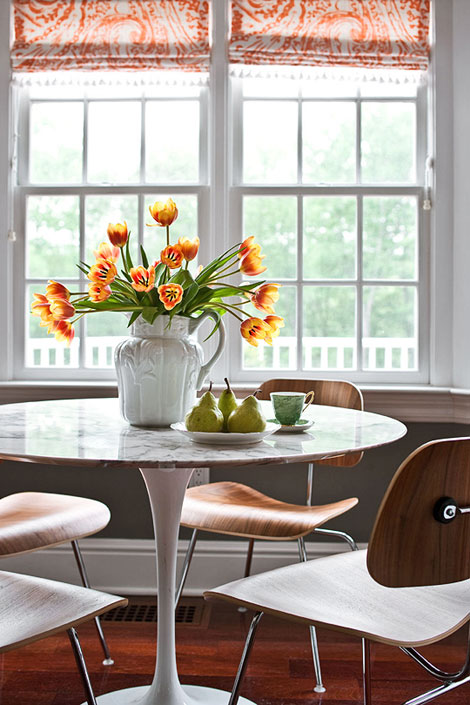
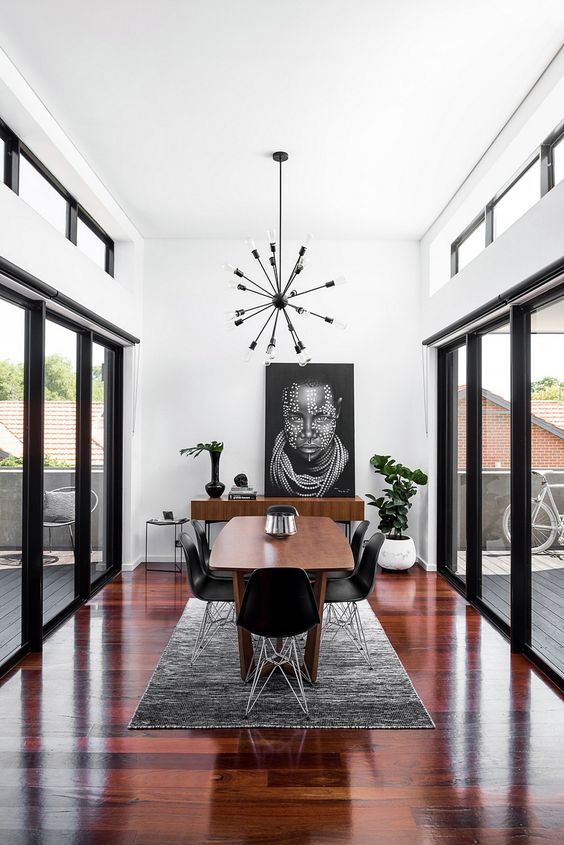
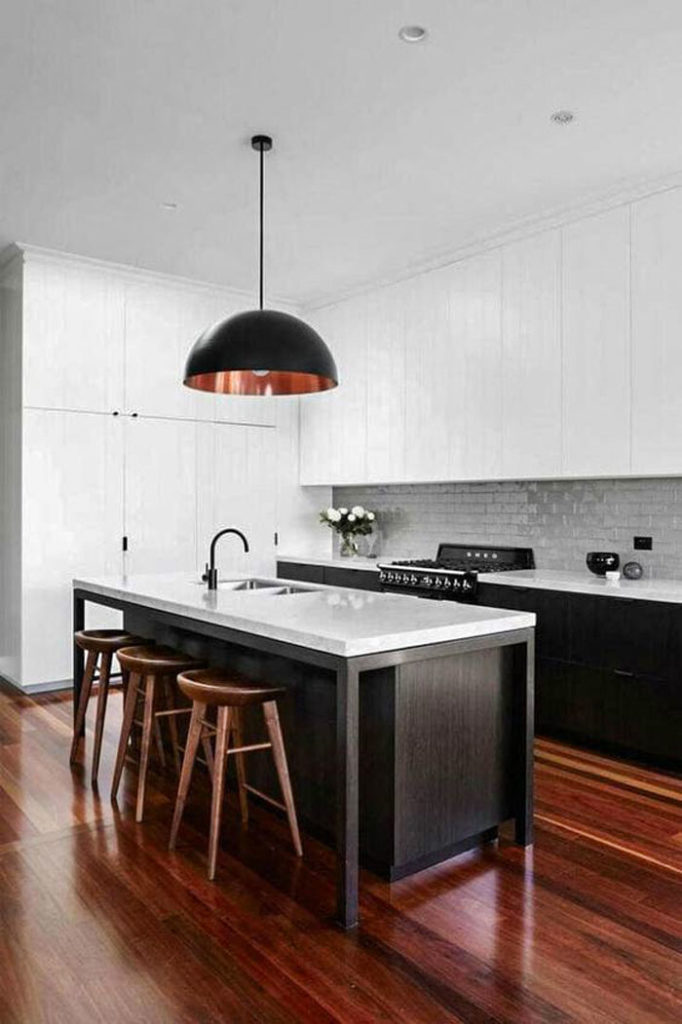
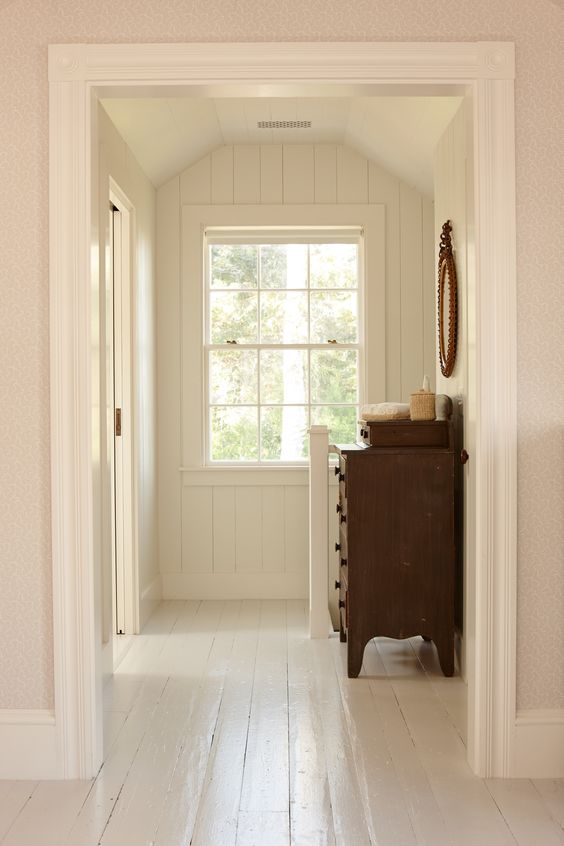
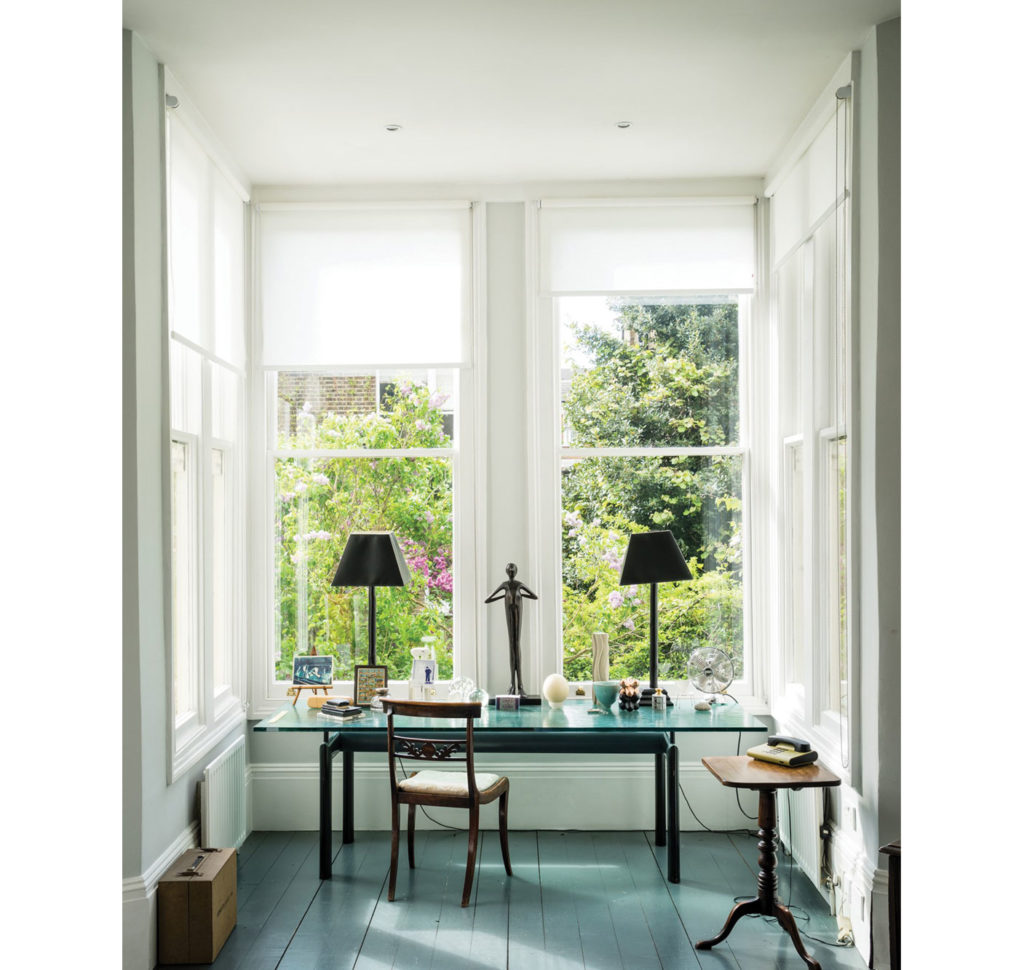
Instead of painting the wood floors, could they be stripped and re-stained a better colour?
Yes it can be done.
That depends on how thick the planks are. If they’re engineered hardwoods, probably not because they have to be sanded to restain them. Otherwise, that’s a option.
Which has been and would be my first choice if they are good quality wood floors! I simply don’t understand the ripping out of wood floors but then again, I’ve never seen new homes with ‘engineered’ wood flooring…I’d bet most homes in the NE USA have authentic wood floors. Strip, stain and re-finish! ALWAYS in style!
Some engineered floors can be sanded once or twice. It depends on the thickness of the top layer.
Thank you Maria for all this very informative blog.
Too red and too orange is a true challenge. I am now 79 years old. As a little girl, my floors in my bedroom were painted almost every year. Wide plants, big baseboards and I just loved it. Mom and Dad refinished the downstairs floors, but I’m special, so I got the gorgeous painted floor. Wasn’t in their budget to refinish my floors and I’m so happy.
You are a true inspiration.
Great post! Thank you so much!
Yes ,no need for wasteful renovations, not even for exaggerated tones. Those can be refinished or repainted if need be, not need to be torn down either.
This is key for me: wood should be kept if at all possible. There are options with real wood. Sanding and restaining is possible if the planks are thick enough or painting. I feel the same way about a lot of cabinets. I hate the trend to install cheaper cabinets that look painted but are actually laminate on MDF. You can’t fix those once water intrusion occurs. But wood cabinets can be fixed and painted! My last house had the orange-brown tone wood floors. I did not replace them. They were not in perfect shape, but they were wood. Right now I’m replacing the cabinet doors on my bathroom vanity because the frame is wood, but the doors were laminate and already peeling off due to the spray cleaners the previous owners loved to use. But why rip out the whole cabinet just to replace the doors? Some enamel paint on the box and the new wood doors and it’s all new! So I love the emphasis on keeping what you can and working with it.
Thank you, Thank you, Thank you! I have been struggling with my Tuscan style and bringing it up to date. I read your posts regularly and have been so helped. it is nice to see my instincts were pretty good too. I am however struggling with a problem that more people may share. i have come to terms with my cognac-ish orange hardwood, however the tile in the rest of the main floor needs to be replaced. I don’t want it to seem too choppy and wish for some flow. Any recommendations on tile color? I have brought blues, greens and aquas into the home with some touched of orange. We live in Florida and the style here has been a challenge for me as we are not coastal and I prefer a more traditional or even cottagey style. Any advice would be so appreciated. This post was amazingly helpful and really helps keep me on track as I continue to update and ditch someone else’s taste!
I’m not going to offer any tile advice other than to KEEP using tiles rather than putting down any more hardwood in any house in Florida. You’re one hurricane away from ruined hardwood flooring. I grew up there. Our mid-century ranch houses had terrazzo flooring throughout to deal with the inevitable water forced in windows or under sliders during hurricanes. My mom still put her oriental rugs down to cover most of the floors, but rolled them away from doors and windows during storms. Modern Floridian houses should use tile throughout the first floor (Mom hated her terrazzo floor buffer!). Northerners who transplant themselves down to Florida need to get used to having waterproof floors, at least on the first floor. And if they’re smart, they won’t buy a house with a second floor at all. Houses will come through hurricanes more intact if they hug closer to the ground, and slightly elevated on stilts if they’re right on the beach. Go on the web and look for pictures of the aftermath of Andrew for a graphic illustration of what I’m talking about with second stories. About the most damage that will happen to a traditional single story cinder-block ranch house in Florida is having corners of the roof ripped off. The rest of that kind of house will survive a storm of any magnitude.
I don’t know, Claire. My grandparents built a late 1940s mid-century house in Miami on a raised foundation with wood floors that’s still standing.
You can’t use wood floors on a flat concrete foundation, but in those days the foundations were always raised and nearly everyone had wood floors. The only terrazzo my grandparents had was on their screened porch.
There are more hurricanes now, but they did go through a couple of big ones in that house, though they got off lightly not being too near the coast.
My mother later built a house in Florida on a flat foundation and had to use Pergo. They do have water-resistant realistic laminant now at least.
Try to find pictures of “Old Palm Beach” style interiors. It’s very traditional, yet tropical.
Oops. This reply was meant for Alyson Carey Goods.
I’m the opposite of you, Maria – I could live with decorating my house in red/black/white if I had to, but being forced into orange and warm tones? No way!
Sand the floor and leave it the natural wood colour, no stain, just the clear acrylic varnish. Great blog Maria!
Wonderful post Maria! Even though my husband had to have dark wood floors, which can be impractical, I have an appreciation of how elegant they look against lots of white molding and our black & white marble entry floor. They are a brown tone, similar to Jacobean or Dark Walnut. Yes, a bit harder to keep clean – as you will notice dust and lighter specs faster, but fortunate that they’re a matte finish and not very red at all. Your photo of the examples of challenging wood with X’s is very helpful. And so is that beautiful photo of the Craftsman style home with walnut-trimmed windows and doors. The white in that room looks amazing (similar to @stevecordony on Instagram).
OK yeah, but those Dalecki Design floors are gorgeous in a gorgeous black/white/grey minimalist house that showcases the flooring beautifully.
What a great post! So much great info and advice. We added a sunroom to our home off of our kitchen three years ago. I followed your advice and am beyond thrilled with the results. We have hardwood running throughout. We were lucky enough to find a perfect match to existing wood floor and the look is seamless. Went with a beautiful greige paint color and I couldn’t be happier. It cools down the floors and balances the large expanse of warm wood perfectly. Added lots of lamps lol (I love lamps) and have lots of windows to let natural light in. Thanks once again. I love learning new things and then putting them into practice.
Very timely post! I was just thinking this morning about repainting a hallway that is nothing but walls and hardwood floors (red oak species wood stained in golden oak). So they fall into the “not too bossy” but not totally neutral category. Since it is a narrow hallway, there’s not a lot of opportunity for otherwise “decorating.” I wonder if you would consider expanding on this post and giving one or two examples of paint colors and whites/creams that compliment each of the hardwood colors in the chart you did. I love how much I always learn from you!
Maria, this is probably one of your best posts EVER. The last one on white walls too. You are KILLIM IT! Haha!
I agree! This was an especially good post! All my questions answered, even before I thought of some of them. Thanks, Maria!
Def a really useful and info packed post. Maria, would you paint white oak herringbone floors a white and give them a very durable clear coat? I love mine that are in both a kitchen and connecting family room, but I dont think they have worn well vis a vis water around the sinks and slider doors. I love the look (although they are not the chevron that is trendy here and has been in France for centuries), but I think it would brighten the space and protect the floors. Too informal an installation to paint? What do you think?
Maria, you are on fire lately! Could you do another post on mixing metals as that seems like such a hot topic lately and the choices are dizzying!
I’ve got an open concept kitchen, dining, and living room area. Don’t know how many metals are too many (or is there such a ting as too many metals?) I’ve got white cupboards, black countertops, stainless steel appliances with black, a spot free stainless faucet and my kitchen cabinet hardware will be chrome so I don’t overload on too much black. Until I can afford new ones, I want to spray paint the espresso metal on my glass coffee tables, console and end stands a soft matte gold (yup, I fell into the matchy-matchy trap of matching end stands and coffee tables). I know if I did that I’d have to incorporate some gold in my kitchen. Is a total of 4 metals too many metals to be mixing? Also is chrome too modern and can it be incorporated into a casual, slightly rustic decor?
Maria, I love all that I learn reading your blog!! This might be a dumb question, but if I’m trying to downplay the orange or red in my wood floor, should I paint my walls a complementary color to quiet the overall bossiness of the wood, or will it bring out more of the color in the wood?
thank you for all the advice you give us.
Maria
Can you list colors of neutral, brown flooring please?
Every wood takes a stain differently, just search medium brown online and they all come up immediately. Maria
I loved my Brazillian Cherry floors when I installed them in 2008 and still do in 2023 (sigh), albeight not as shiny as they were15 years ago, love them more now. And I Looooove the picture above with the reddish floors. Because I don’t decorate much, have an outdoor view to kill with plendy of natural light, my reddish floors are all the decor I need. White walls, minimal furnishings and a greyish rug such as to “slightly” deter the red is perfect for me. But I’m different than most anyways, I don’t tend to like what everyone else does until the fad is probably way overdue. Lol, it’s always been obvious that you dislike these color floors. But I still value your input.
So if my more-or-less neutral brown floors look reddish against my taupe/greige wall paint, how do I decide which is boss going forward?
I LOVE THE BURGUNDY RED OR WHAT YOU CALL CHERRY RED FLOOR. IF I WAS GOING TO PAINT A WOODEN FLOOR INSIDE MY HOUSE I WOULD CHOOSE THAT CHERRY RED OR MAYBE ONE A SHADE OR TWO DARKER RED, BUT I DO LOVE THE SHINY CHERRY RED COLOUR.